Pest management in day-neutral strawberries
Learn strategies to manage pests in day-neutral strawberries.
Before planting
Popular day-neutral varieties tend to be very susceptible to soil born root diseases and nematodes, and so day-neutral strawberry growers should pay attention to soil health. Growers who plant strawberries after strawberries, with only a year or two between crops, often rely on soil fumigants before planting to control these pests. Without soil fumigation, you will need long (4–5 years) rotations between strawberry crops, and use of pre-plant cover crops to reduce nematodes and soil born diseases.
Weed control
In a plasticulture system, there are two types of weed problems - in the planting hole and in the alleyways. In both cases, it is important to start with a site that has low weed pressure. Herbicides should never be applied over the plastic because residues can bind to the plastic and harm the plants, and they can wash into the planting hole and concentrate around the plant.
One way to reduce weed pressure is to pay attention to the size of the hole made in the plastic mulch when planting. Smaller holes are made when a wheel is used to mark the holes rather than punch holes in the plastic, and when a narrow blade-like planting tool is used to push the plants through the plastic. After planting, hand-weeding is important. Some growers assign rows to each worker, who is then in charge of harvest, runners and weed management in that row.
To control weeds in the alleys you will need specialized equipment for either mowing or herbicide application. A boom sprayer with spray hoods allows growers to apply herbicides to burn off weeds in the alleys followed by application of a residual product.
Insect pest management
Insect pests of day-neutral strawberries include tarnished plants bug, spotted wing drosophila, spider mites, and western flower thrips. (Figure 1. Tarnished plant bug nymph) There are lots of natural enemies and beneficial insects that help keep thrips and spider mites under control. However, spraying for tarnished plant bug and spotted wing drosophila can be very hard on these natural enemies, and lead to sporadic outbreaks of these pests.
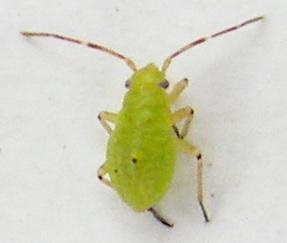
Figure 1. Tarnished plant bug nymphs.
It is important to scout for tarnished plant bugs (TPB) during the bloom and green fruit period of strawberries - which, for day-neutral growers, means weekly scouting and management decisions throughout the summer and fall. (Figure 2 Damage to strawberries caused by tarnished plant bug)
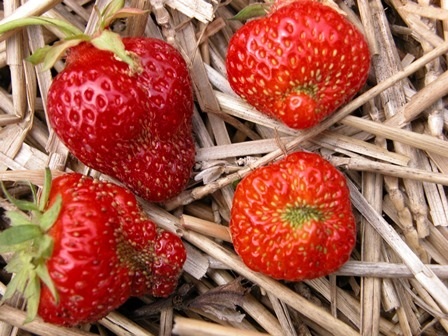
Figure 2. Tarnished plant bug damage.
Tarnished plant bug nymphs damage strawberries by feeding on bloom and green fruit, causing cat-facing and fruit deformation. Poor pollination and some environmental conditions can also cause deformed fruit. Tarnished plant bug damage is distinguished from these conditions by looking at the seeds. When damage is caused by pollination or environment, seeds stay tiny and don't develop. When damage is caused by TPB, seeds in the damaged area are fully developed and approximately the same size.
Monitor for tarnished plant bugs by tapping blossom clusters over a dish or tray. The threshold for control is approximately one plant bug nymph in 4 plants or taps. You should look at approximately 100 clusters per field each week. A sequential sampling method allows scouts to reduce the sample size when populations are very high, or very low. See Ontario.ca/cropipm.
In June-bearing strawberries, you can reduce TPB damage by controlling the first generation of nymphs with 1 or 2 well-timed sprays during bloom. However, in day-neutral strawberries, the second and third generation of tarnished plant bugs can also cause considerable damage. This second generation of TPB nymphs usually peaks in early-mid July, when day-neutral strawberries have abundant bloom. TPB at this timing can result in considerable damage, so monitoring is important.
Western flower thrips can also show up at this time. Western flower thrips are thin, yellow thread- like insects found in the blossom. (Figure 3 Thrips on strawberry blossom) Thrips damage the plant cells by scraping plant cells with their mouthparts and sucking up the cell contents. In strawberries, if thrips are a problem, you will see bronzing on the underside of the sepals, and on the fruit around the seeds. (Figure 4 Damage from flower thrips) Fruit loses its shiny finish, and can become hard and cracked.
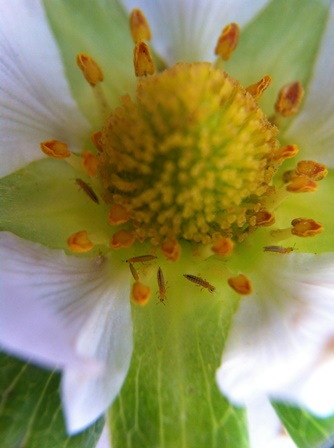
Figure 3. Western flower thrips.

Figure 4. Damage to strawberry by western flower thrips.
In the field, scout for thrips by blowing a quick puff of breath onto the blossom and quickly examining the flower for thrips. Thresholds for thrips on strawberries have not been developed for our region. In dry climates like Israel and Australia, where these pests are a major problem, thresholds of 10 thrips per bloom are used for winter production and 40 thrips per bloom are used for summer production.
In Ontario, western flower thrips are a problem at a small percentage of farms. On these farms we have found that you really can't control them with insecticides. Thrips develop resistance to insecticides very quickly. Beneficial insects, such as minute pirate bugs, are very important for thrips control. These can be encouraged by choosing IPM friendly sprays for TPB, and planting trap crops like alyssum around the field.
Spotted wing drosophila (SWD) is a serious pest of day-neutral strawberries in mid-August and through September. This aggressive, invasive fruit fly lays its eggs in ripening fruit. The eggs hatch before harvest and larvae quickly develop causing soft fruit with poor shelf life. Growers should monitor fruit carefully for SWD damage by routinely sampling fruit and using salt water tests to float out larvae. Control of SWD cannot be achieved by any one method. Growers will need both crop management and use of insecticides for control. Harvest thoroughly every 2 days, rather than using a 3–4 day harvest schedule. Keep your fields clean from weeds, runners and excessive growth, and collect as much ripe from the field as possible. When SWD flies are abundant in the region, insecticides will also be needed.
Two-spotted spider mites (TSSM) require controls in some fields in some years. The overwintering adults are orange, and can overwinter and build up under floating row covers used for winter protection. Check the lower leaf surface of older leaves for overwintering mites. (Figure 5 Damage from two spotted spider mite on strawberry leaf) As plants start to grow, mites move out to newer leaves. Feeding damage from mites appears initially as a white flecking on the upper leaf surface, eventually causing leaves to be bronzed, tough and scorched. In extreme cases, webbing develops.
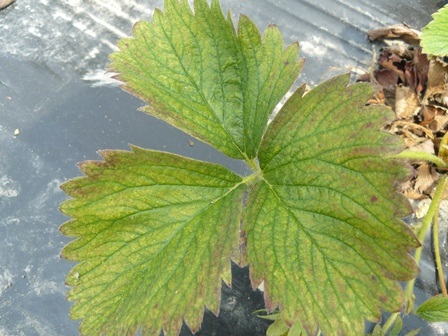
Figure 5. Two spotted spider mite damage in strawberries.
To sample for two spotted spider mite, collect about 50 fully expanded middle-aged leaves from various plants in the field. Assess the populations by checking the lower leaf surface with a handlens for TSSM eggs, nymphs and adults. If mites are present on 25% or more of the leaves examined, the threshold for control has been reached. Predatory mites can be useful for TSSM control, however these can be killed by sprays for TPB and SWD.
Disease management
Botrytis grey mould is an important fruit rot on day-neutrals. (Figure 6 Botrytis fruit) This disease occurs when botrytis infects strawberries during bloom. A soft lesion, covered with brownish or greyish spores, develops near the calyx of the fruit as the fruit ripens. Apply fungicides for botrytis control weekly during the bloom period, especially when the weather is cool and wet. Botrytis can develop resistance to certain fungicides if these fungicides are used repeatedly for control. It is important to know which fungicides belong to which fungicide group, and to choose fungicides from different groups when you are making consecutive sprays.
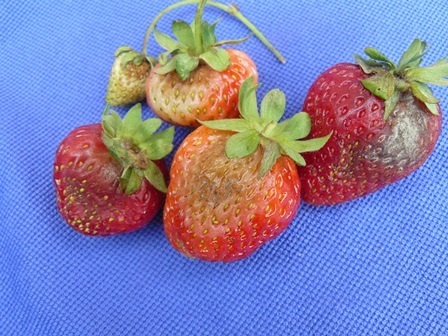
Figure 6. Botrytis grey mould on fruit.
Although there are many fungicide options for botrytis control, the trick is to choose fungicides or fungicide combinations that also control the other two important diseases on day-neutral strawberries - powdery mildew, and anthracnose fruit rot. (Figure 7 Anthracnose fruit rot).
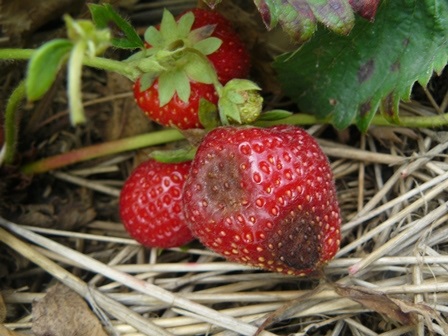
Figure 7. Anthracnose fruit rot.
Some varieties, such as Seascape, and Portola, are extremely susceptible to powdery mildew. (Figure 8 Powdery mildew damage to leaves) Wet humid weather, or frequent heavy dews, can favour this disease. Symptoms of mildew show up first as a white powdery growth on the lower leaf surface of new growth, but this quickly disappears. A light purple speckling develops on the upper leaf surface, leading to purple leaf blotches and sometimes leaf necrosis. On Seascape, powdery mildew can infect fruit and reduce quality. An effective mildew control program should begin at the first sign of speckling and before widespread symptoms develop.
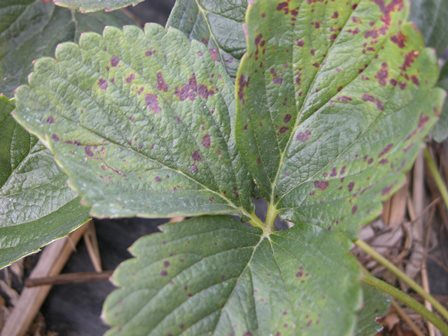
Figure 8. Powdery mildew damage to strawberry leaves.
Anthracnose fruit rot can be devastating. It is common in southern Ontario, and less so in cooler regions. Anthracnose can infect as early as bloom but it also infects ripening fruit, when it is particularly noticeable. Anthracnose can build up in the field before any symptoms appear. Spores are spread by splashing rain and infection is favoured by warm weather. Small black spots show up on fruit that expand to round dark brown to black circular lesions on the side of fruit. Anthracnose lesions can also develop on runners and petioles, and crowns.
Management of anthracnose starts with clean plants from a professional plant grower. Home-grown plugs are more likely to have anthracnose. Spores can be carried throughout the field on equipment and by workers. Because older plantings tend to have more disease, work in older fields last and clean equipment between fields. Avoid working in fields when plants are wet. Fungicides for anthracnose are especially important in warm weather (i.e. temps between 26–32°C) because rains following these temperatures can quickly spread the disease.
Pest management on day neutrals can be complicated. Weekly scouting, together with a good understanding of the biology of major pests, is important for good pest management.
An updated list of pests, timings and products for pest management on day neutrals can be found in OMAFRA publication #360, Guide to Fruit Production, 2016–2017.
Details on strawberry pests and scouting can be found at Ontario.ca/cropipm.